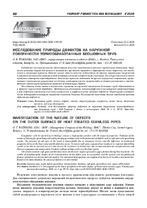| dc.contributor.author | Рожкова, О. В. | |
| dc.coverage.spatial | Минск | ru |
| dc.date.accessioned | 2020-12-17T11:37:35Z | |
| dc.date.available | 2020-12-17T11:37:35Z | |
| dc.date.issued | 2020 | |
| dc.identifier.citation | Рожкова, О. В. Исследование природы дефектов на наружной поверхности термообработанных бесшовных труб = Investigation of the nature of defects on the outer surface of heat-treated seamless pipes / О. В. Рожкова // Литье и металлургия. – 2020. – № 4. – С. 90-93. | ru |
| dc.identifier.uri | https://rep.bntu.by/handle/data/82678 | |
| dc.description.abstract | Соблюдение технологии закалки обеспечивает получение качественного изделия с требуемыми свойствами. Нарушение режимов нагрева под закалку и охлаждения при закалке приводит к образованию таких дефектов, как мягкие пятна и закалочные трещины. Наличие мягких пятен в металле недопустимо по причине структурных напряжений и разности механических свойств между основным металлом и дефектными участками. Для устранения мягких пятен требуется повторная термообработка. Закалочные трещины возникают по причине внутренних напряжений, превышающих сопротивление разрушению, вследствие неодновременности превращений и теплового расширения и сжатия. Изделия с закалочными трещинами являются окончательным браком. Исследованы мягкие пятна и термические трещины на наружной поверхности бесшовных труб, образовавшиеся в процессе термической обработки. Представлены результаты металлографических исследований микроструктуры в зоне дефектов, определены и изучены генетические и морфологические признаки дефектов. Структурная неоднородность подтверждена замерами твердости по методу Роквелла. На основании полученных данных определены причины образования дефектов. | ru |
| dc.language.iso | ru | ru |
| dc.publisher | БНТУ | ru |
| dc.title | Исследование природы дефектов на наружной поверхности термообработанных бесшовных труб | ru |
| dc.title.alternative | Investigation of the nature of defects on the outer surface of heat-treated seamless pipes | ru |
| dc.type | Article | ru |
| dc.identifier.doi | 10.21122/1683-6065-2020-4-90-93 | |
| local.description.annotation | Compliance with the quenching technology ensures a high-quality product with the required properties. Violation of the modes of heating for quenching and cooling during quenching leads to the formation of defects such as soft spots and quenching cracks. The presence of soft spots in the metal is unacceptable due to structural stresses and the difference in mechanical properties between the base metal and the defective areas. To remove soft spots, repeated heat treatment is required. Quenching cracks occur due to internal stresses that exceed the resistance to destruction, due to non-simultaneous transformations and thermal expansion and compression. Products with quenching cracks are the final rejects. The article examines soft spots and thermal cracks on the outer surface of seamless pipes formed during heat treatment. The results of metallographic studies of the microstructure in the defect zone are presented, and the genetic and morphological features of defects are determined and studied. The structural heterogeneity was confirmed by Rockwell hardness measurements. Based on the data obtained, the causes of defects were determined. | ru |

